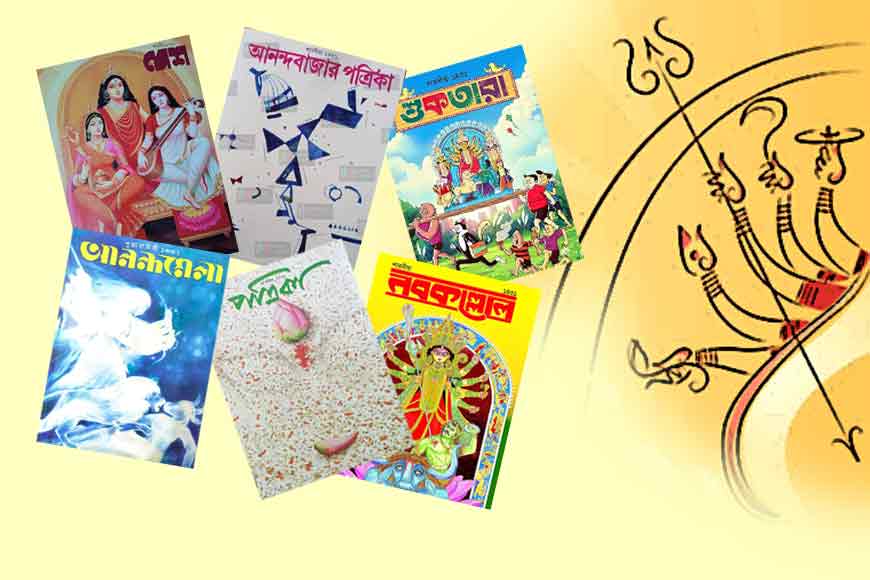How Pujabarshikis became an intrinsic part of Bengal’s Durga Puja—GetBengal story

Durga Puja is the foremost socio-cultural festival in Bengal. As the countdown to the autumn festival begins, the puja spirit catches like wildfire and Bengalis go into a frenzy of celebrations. It all begins with the publication of ‘Puja Barshiki’ (annual puja periodicals), a tradition that heralds the beginning of celebrations.
As the festive season approaches, a number of publications release puja magazines. However, the demand for such magazines may not be as high as it used to be before the invention of smartphones. Yet the Puja Barshiki magazines remain not only in circulation but also in demand. According to a newspaper survey, the number of newspapers published in Bengali (in magazine format or e-format) that focus on Durga Puja around the world is around five thousand. Some of them are commercial, some non-commercial, and some published by private initiatives.
Bengalis are known for their creative intellect. No other province except undivided Bengal (former East Pakistan, aka Bangladesh and West Bengal) publishes literary works on socio-religious occasions like Durga Puja, Eid, or any other religious festival. The custom of publishing a special Sharadiya issue during Durga Puja started in 1872 (1279, according to Bengali Sambat, aka BS). 'Sulabh Samachar', a weekly newspaper founded and edited by Keshab Chunder Sen, published its first autumn issue in English in 1872 as 'Chhutir Sulhabh'. A special edition was published in the month of Ashwin, 1280 BS (1873). It was priced at one paisa. Other regional vernacular newspapers like 'Sadhana', 'Bharatbarsha', 'Bangabani', 'Anandabazar', etc. joined the fray and started publishing special Puja editions as well.
Many distinguished authors, like Dwijendralal Roy, Satyendranath Dutta, Sarat Chandra Chattopadhyay, Prabhat Kumar Mukhopadhyay, and others, contributed to these puja special magazines.
Rabindranath was the brain behind synchronising Sharad Sahitya with Akaal Bodhan. Akaal Bodhan is the untimely invocation of Goddess Durga (as per legend, Lord Rama invoked Goddess Durga in autumn and sought her blessings before his battle with Ravana). 'Sadhana', a Bangla periodical, was first published in the month of Agrhayana 1298BS (December 1891). Although 'Chhuti Sulabh' was the first autumn issue, Bengalis got their first autumn edition in the vernacular with the publication of ‘Sadhana.’ In 1299, the combined Bhadra-Ashwin issue of Sadhana Patrika appeared on the stands as a Sharad issue. That particular edition is considered one of the best autumn numbers to date. Rabindranath’s nephew, Rabindranath Tagore, edited the magazine, and Rabindranath himself contributed a short story to the supplement.
"As the month of Ashwin begins, the countdown for Durga Puja begins. From the day of Chaturthi, boats begin to approach from distant lands and anchor at the ghat. Expatriates, who have been toiling at their workplaces, are returning home to join in the annual festivities... Monsoon has left the land, and the autumn sunbeams glow like a festive smile in the cloudless sky. There is a nip in the air, and the rain-washed verdant fields seem to shiver in the breeze.'' Rabindranath’s vivid description using beautiful and introspective words prepared everyone for the joyous occasion. His descriptions created an intense and clear impression of the upcoming festival.
It was this evocative quality of Tagore's writing that made editors yearn to coax out write-ups for their respective puja specials. He would be flooded with requests to contribute to these special issues every year. In 1325 BS (1918), Rabindranath's youngest son-in-law (Mira Devi’s husband), Nagendranath Gangopadhyay, edited the Puja special edition of 'Parvati' magazine. It is probably here that Rabindranath’s first Puja song, “Shorote aaj kon Atithi elo praner dware" (Who is this guest who comes knocking on the door of my heart on this autumn morning?) was published.
The first novel published in a Puja Special was in Sharadiya Basumti. Anandabazar newspaper published its first autumn issue in 1926. Several years later, Manik Bandyopadhyay's novel 'Shahartali' (Suburb) was published here. Rabindranath's famous story, 'Robibar' was also published here. Next year, the novel 'Laboratory' was released in the Sharadiya edition.
The autumn issue of Desh Patrika was first published in 1341 BS (1934). In 1356 BS (1949), Subodh Ghosh's ‘Trijama' was the very first novel published in Desh Puja Barshiki. From the 1960s, publishers started offering a number of novels, even five or six novels, in the irrespective puja editions. These were penned by renowned contemporary authors of the time. If we leaf through the vintage Puja Barshiki issues of Desh, the first and foremost author in the index is Rabindranath, with his vast treasure trove of unpublished writings and correspondences. An article would follow this on any aspect related to Rabindranath.
After authors like Tarashankar Bandopadhyay, Manik Bandopadhyay, and Bibhuti Bandopadhyay stepped down, their baton was passed to the next generation, which included Samaresh Basu, Ramapada Chowdhury, Bimal Kar, Jyotirindra Nandi, Sunil Gangopadhyay, Shirshendu Mukhopadhyay, and Samaresh Majumdar. Satyajit Ray introduced us to the world of the super-sleuth Felu-Da, aka Pradosh Chandra Mitterin, his first novel published in the Desh Puja Special Edition. Most teenagers were introduced to Kikira, Professor Shanku, Gogol, Colonel, and Magician through novels published in Puja Barshiki Anandamela.
Puja special numbers have been the most important event in the annual calendar of Bengali literature. It has become an integral part of the Sharodiya festival and a part of Bengali's own unique culture. Puja festivities seem incomplete for most without these annual Sharadiya editions of magazines.
The older generation often disparages the younger generation's habits and their decreasing interest in reading as they are increasingly drawn to visually engaging and short-form content, which is easier to consume than books. However, going by the sale of puja-special magazines, it is clear that they not only remain in circulation but are also in demand. Innumerable commercial and non-commercial magazines, blogs, and even e-magazines are published during Durga Puja, and new and upcoming authors get a larger platform to showcase their works. There are many magazines that appear just once a year as puja numbers, and almost all publications get a good sale as Bengalis from all corners of the world collect these special puja editions.
Some of the buyers spend thousands to collect puja specials. There may be a vast difference in time and literature between then and now, but there are people who still love to explore and want to engage with vernacular media. This is a positive aspect of the festival that should be encouraged and welcomed!










